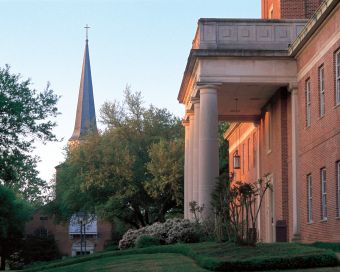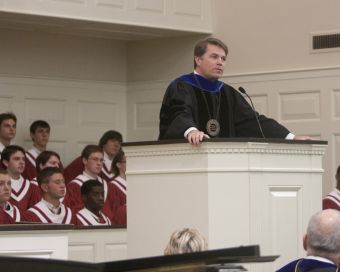article reprinted courtesy of The Chronicle of Higher Education, © 2011, all rights reserved
written by Lawrence Biemiller
In Louisiana, a Small College Gives Itself a Makeover
Can small liberal-arts colleges go on being all things to all people in an era of reduced resources and increasing competition? At least one—Centenary College of Louisiana, in Shreveport—has decided it can't. After years of running deficits and watching enrollment falter, it's cutting the number of majors it offers in half, from 44 to 22, and focusing its curriculum on what it sees as the challenges of the 21st century.

It's too early to say whether Centenary's effort to pare itself back to viability will make it a model for other institutions its size. The college took a big hit in admissions after announcing the changes in February of last year, more than halfway through the annual admissions cycle. And its discount rate for freshmen—67 percent in the fall of 2009—still needs to be brought under control.
But administrators say that they're on track to finish in the black for a second year in a row, despite a small freshman class, and that the refocused curriculum makes a lot more sense than its sprawling predecessor. B. David Rowe, Centenary's president for the past two years, puts the college's aim succinctly: "You've got to know, name, and claim your strengths, and accentuate those."
Until three years ago, Centenary had been covering operating overruns by taking annual payouts of more than 8 percent on its $104-million endowment (5 percent is the norm). But in 2008, while spending of $28-million topped revenue by $1.5-million, the recession cut endowment income and gifts to about $10-million below the previous year's level.
After calling in a strategic-planning consultant, the 850-student college's Board of Trustees approved laying off 25 people?—about 15 percent of its administrative staff—and deferring some maintenance. The board also brought in a new president, a new provost, and new vice presidents for development and enrollment management. And it announced that Centenary was leaving the NCAA's Division I, of which it had long been the smallest member, for Division III—that move alone will save $1-million a year.
But bigger changes were yet to come. The new president, Mr. Rowe, and an interim provost, Daniel Keck, gave a faculty committee three months to take a hard look at Centenary's curriculum and shrink the $11-million instructional budget by $1-million. And, says Mr. Rowe, "I asked for a fiscally sustainable plan for growth."

David Rowe, president of Centenary College, speaks at commencement. The Board of Trustees brought in Mr. Rowe and several other new leaders in conjunction with a new strategic plan.
When the committee reported back, in early 2010, it outlined sharp cuts in the curriculum. It also proposed that Centenary redefine itself by focusing programs on giving students both the capacity to meet the challenges of the 21st century and opportunities for hands-on engagement with issues.
"There were good, strong reasons why those programs were started," says Michael Hemphill, the provost, of the majors Centenary is dropping, which include accounting, dance, elementary and secondary education, German, health and exercise science, music performance, and others. "But over time they became a huge weight for the institution to carry."
The Challenges of Shrinking
The college, which dates to 1825 and is affiliated with the United Methodist Church, pledged that students who had already chosen the doomed majors could complete them. But four tenured professors and a similar number of untenured faculty members were told they would be let go once the students enrolled in their programs graduated. Some of those faculty members have left the college already, while others will remain for another year.
The consultant to whom the board turned, Thomas C. Longin, is a senior fellow at the Association of Governing Boards of Universities and Colleges and president-elect of the Society for College and University Planning. "When I work with these places, I say, We've got to find a way to plan strategically, because you won't survive just running operationally," he says.
His prescription for small colleges is straightforward: Take "a close look at what you should be shutting down, where you should excel." And try reinventing the institution around its mission, he says. "What's the contemporary manifestation of their mission? That holds them back. They don't think of the mission as empowering." The real difficulty, he says, is that if an institution waits to start the process until its back is already up against the wall, it may not be able to afford to shut some programs down at the same time that it's overhauling others—or to take a temporary enrollment hit that slices into total revenue, the way Centenary has. And it may be that only a new president with strong board backing could demand the sweeping changes that such an overhaul requires.
Centenary's curriculum cuts weren't based solely on which majors attracted students, Mr. Hemphill says. "There are certain programs that the task-force members could look at and say, We value the presence of that program regardless of the cost. But they were also influenced by the viability of a lot of those programs that didn't have many, if any, majors in them. There were real budgetary constraints that had to be taken into account."
Since the changes were announced, faculty members have been working to come up with ways to refocus existing courses and give students the opportunities for engagement that the committee proposed as a new centerpiece. A French-immersion "living-learning community" was an early offering, and will be followed this coming fall by a sustainability house organized by an English professor, a physicist, and a political scientist.
Centenary is looking at the sustainability program as proof of the curriculum revision's concepts. Jeanne Hamming, an associate professor of English who is the point person for the program, says the president located donors to pay for about $200,000 worth of renovations to make a residence hall more sustainable. "Professor Hamming heard from students that they wanted to live in a real community and do something to make a difference in the world," says President Rowe. "I think that's where we might be stumbling on a secret."
Starting this fall, students will live together in the dorm, take a lecture course together in the fall, and then create a lab project in the spring to put what they're learning into action. They might, for instance, work with a local group pushing for more bike lanes and nature trails around Shreveport. There's already a waiting list to get into the program, known simply as the Green House.
'Quick Maneuvering'
But overhauling a curriculum on the fly is hard work, Mr. Hemphill says. Although many majors are being terminated, lower-level courses in most of the those disciplines—accounting, dance, physics, Spanish—will remain in the catalog. The college's business offerings are being thoroughly reconfigured. At the same time, individual courses across the curriculum need to be revamped to meet the new emphasis on 21st-century challenges. "I heard one faculty member refer to it as reading a map while riding a bike," says Mr. Hemphill.
The college is continuing to watch its expenses closely, he says. A Moody's Investors Service report that revised the outlook on the college's $14.7-million in debt from negative to positive notes that the college cut costs 9.8 percent in its 2010 fiscal year, in part because of the move to Division III athletics. The analysts praised the college's new "intolerance" for deficits and its "commitment to move to a reduced endowment-payout rate"—now reduced, President Rowe says, to 5 percent.
Despite analysts' optimism, the changes have not brought Centenary an immediate turnaround. "Our biggest challenge was the year that this decision was made public halfway through our cycle," says Mickey Quinlan, director of admissions. Once members of the admissions staff were clear themselves on what the changes meant, "we had to do some quick maneuvering," he says. "We lost a lot of students, to be honest, that first year—especially in some of the programs that were being phased out." Last year's freshman class came in at about 200 students, down from 278 the year before.
At the same time, the college took some hits in the media for the changes, especially for the decision to leave Division I. "We got some bad press, some inaccurate press, that made it look like Centenary was just crumbling at the pillars, not that we were being proactive, which we were," says Mr. Quinlan.
Dave Voskuil, who took the new post of vice president for enrollment services in February 2010, is philosophical about the coverage. "You're going to get ripped one way or another when you make a bold move," he says. "But colleges that don't make a bold move won't have to worry about getting ripped down the road, because they won't be there."
And the admissions picture for the coming year looks better, says Mr. Voskuil, the first Centenary staff member to oversee both admissions and financial aid. The number of deposits is up from last year, the academic profile of students who have sent deposits is better than that of last year's freshmen, and the tuition discount the college has offered to attract those student is lower than last year's 61 percent.
Still, Mr. Hemphill says the college would like "a couple of hundred more students" over all. Mr. Voskuil hopes the curriculum changes will produce a program so attractive "that parents and students will find a viability and a value and won't have to have a full scholarship to want to be part of it."
Markers of Viability
Not surprisingly, the college's overhaul has some critics. Daniel Henderson, who took a job as an assistant professor of exercise science at Centenary six years ago, says it makes no sense to shutter the health and exercise-science program, which he says was a "cash cow," with more than 60 majors.
"We still can't really figure out why we got targeted," says Mr. Henderson, who accepted a teaching post at Hendrix College this spring. He speculates that even though his old department's focus on the science underlying human performance would have fit well into Centenary's new emphasis on 21st-century challenges, the department had never been able to shake an old reputation "as a dumping ground for dumb Division I athletes." And, he adds, "we were an easy target because we had no tenured faculty."
President Rowe says the college faces tough challenges going forward. "As you're trying to prime the pump for new initiatives, it's difficult not to resort to the same logic that got you in trouble in the first place"—like taking 8-percent endowment payouts. Maintaining fiscal discipline, he says, will be one of three markers by which to judge for Centenary's viability as a liberal-arts college.
The other two have less to do with money than with keeping the college's vision of itself current. "Another marker will be when we're as willing to let go of things that we value as we are to embrace new things," Mr. Rowe says. "And the third will be when every faculty and staff member and student can articulate why the world would be lacking if it weren't for Centenary College."
article reprinted courtesy of The Chronicle of Higher Education, © 2011, all rights reserved
